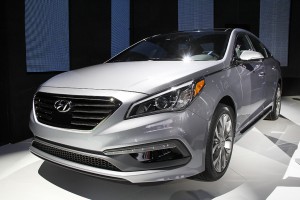
Hyundai introduced the 2016 Sonata hybrid and plug-in hybrid at the Detroit Auto Show. Photo credit: Len Katz
Hyundai jumped into the midsize hybrid vehicle fray this week with both feet, or versions anyway: gas-electric and plug-in hybrid with the Sonata at the Detroit Auto Show.
The plug-in version is new for Hyundai and marks the first time the Korean automaker has offered one. The Sonata PHEV can travel 22 miles in pure electric mode, which the maker claims is farther than any other midsize PHEV. Sonata PHEV is expected to deliver 93 MPGe combined in EV mode based on internal estimates.
It’s powered by a 9.8-kWh lithium polymer battery and a 50-kW electric motor. Recharge time ranges from two and a half hours at a 240V Level 2 charging station to five hours using a standard 120V outlet.
If the battery is exhausted, the 2.0-liter four-cylinder engine developing 154 horsepower and 140 lb-ft of torque takes over averaging 40 mpg. Combined the two motors put out 202 hp.
(Hyundai Santa Cruz concept asks: when is a truck not a truck. For more, Click Here.)
Perhaps the best feature of the new hybrid is the smartphone app that allows owners to manage and monitor the car remotely. Using the app, owners can access real-time data from their Sonata PHEV and perform specific commands like starting the engine and locking doors. They can also use it to search for points of interest using Google with voice or text and have the directions when they start the car. The app also allows for managing the charging schedule of the car.
(Click Here for details about Hyundai’s $74 billion investment plan.)
The non-plug-enabled iteration gets a 10% boost in fuel economy over its predecessor, which was listed at 38 mpg combined. It’s powered by a 51-hp, 38-kW electric motor that offers 151 lb-ft of torque in concert with the aforementioned 2.0-liter four-cylinder engine and a net power rating of 193 horsepower.
(To see what “ruinous” business practices Marchionne says are threatening the auto industry, Click Here.)
The hybrid’s powerplant is a lithium-polymer battery pack with a 1.62 kWh capacity, a 13% improvement over the early version. Additionally, the battery pack fits under the trunk floor, which allows for a flat trunk floor as well as available 60/40 split-folding rear seats giving the new Sonata more cargo space. In fact, so much more that it is now the class leader with cargo volume of 13.3 cu. ft., a 10% improvement over the previous Sonata Hybrid, as well as best-in-class passenger volume at 106.1 cu. ft.
